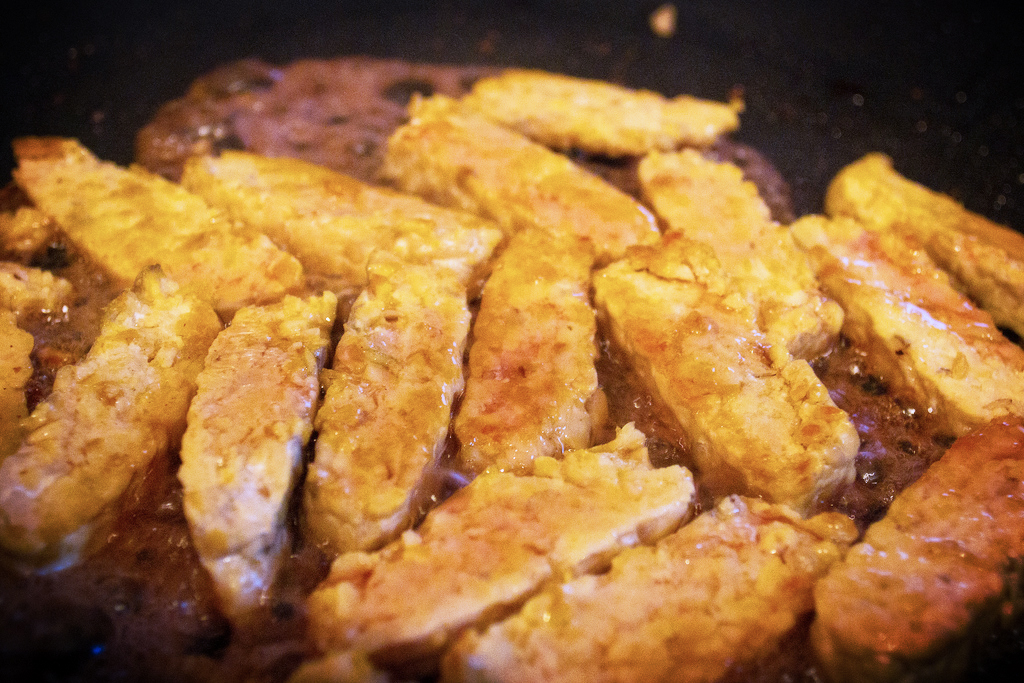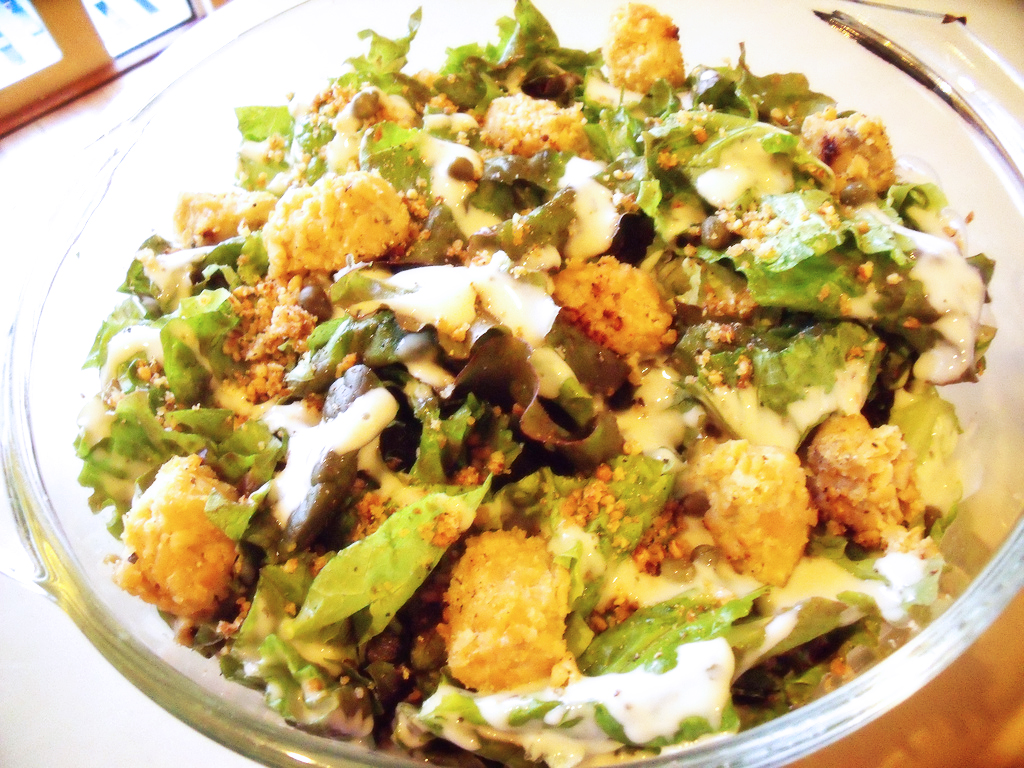Make 2015 the Year of Tempeh for the Weeknight Vegetarian
Maybe one day, because of the growing number of people seeking vegetarian meals, meat alternatives, fermented foods or all of the above, a certain soy product with age-old ties to Indonesia will finally break into the U.S. mainstream.
Call it my New Year’s wish.
Joe Yonan is the Food and Dining editor of The Washington Post and the author of “Eat Your Vegetables: Bold Recipes for the Single Cook.” He writes the Food section’s Weeknight Vegetarian column.
I’m talking about tempeh, the cultured soybean cake with as much protein as beef. If you’ve seen it, it has probably been shrink-wrapped in the refrigerator case at your nearest Whole Foods, next to the tofu and the seitan and some veggie “crumble” or another. Or maybe you’ve tasted it in a veggie burger or on a vegan Reuben, or you’ve tried smoky strips marketed as Fakin’ Bacon.
What you might not have realized is this: Fermentation makes tempeh quite possibly the most nutritious, digestible form of soy around. It’s also one of the least-processed, using the whole bean (as opposed to tofu, made from soy milk).
At least in this month of resolutions and recovery, tempeh should be on your agenda. And it doesn’t need to taste like punishment: Tempeh has much more than nutrition to recommend it, including an earthy, slightly bitter, even somewhat sweet flavor and a firm, nutty texture, giving it more character than tofu will ever possess. Yet, like tofu, it can be a chameleon, soaking up more flavor from marinades and sauces, which makes it surprisingly versatile.
If you know how to cook it, that is.
Like many vegetarians, I was first drawn to tempeh a few years ago as a plant-based protein. I opened a package of Lightlife brand, cut it into thick slabs, pan-fried it — and watched in awe as it absorbed as much oil as I could put in the pan, and then some. I seasoned it lightly with salt and pepper, took a bite, and . . . . hmm. It was a little dry inside, with a slightly sharp flavor. This obviously was an acquired taste, I figured, which I obviously hadn’t yet acquired.
What was I expecting? How many proteins taste all that great after a mere pan-frying? (Bacon lovers, don’t answer that.) Soon enough, I started glazing tempeh after I pan-fried it, usually in a soy-sesame combination or sometimes one of miso, mustard and honey. I liked it much better — enough to cook it now and then, but not often enough to make it as much of a go-to ingredient as, say, beans.
It wasn’t until I started treating tempeh as seriously as I do other staples, seeking out tips and recipes, that I began to unlock its potential. Now that I’m falling for tempeh, I’m falling hard.
Fermentation makes tempeh one of the most nutritious, digestible forms of soy around.
‘A magical kind of substance’
It hasn’t been difficult to find fellow enthusiasts. “You’re talking to two tempeh lovers,” said Joy Pierson, who owns New York’s vegan Candle Cafe with her husband, Bart Potenza.
“Tempeh, tofu and seitan are the holy trinity of the vegan diet,” Potenza added. “But tempeh is the best.”
Amy Chaplin, author of “At Home in the Whole Food Kitchen,” has been eating tempeh occasionally since her childhood in Australia (and childhood trips to its birthplace of Indonesia). A recipe in her book served as my gateway to a new level of tempeh understanding: marinated in apple juice, mustard, tamari, olive oil and vinegar, then baked in the marinade. The tempeh absorbs every bit, becoming infused with a complex, slightly tart, savory goodness. I made it once, then quickly made it again: I’ve eaten it on salads and sandwiches and as a from-the-fridge snack, and as soon as I run out, I want another batch.
To Chaplin, former executive chef of New York’s Angelica Kitchen and now a private chef to such clients as Natalie Portman and Liv Tyler, the keys to tempeh success include cutting it thinly and marinating it. When you treat it right, “it’s so good!” she exclaimed in a phone conversation. “And it’s a much healthier food than tofu. Soy has such a conflicted reputation, so I tell people to just focus on fermented soy.”
Fermentation reduces soy’s high levels of phytic acid, a substance that hinders the body’s ability to absorb minerals.
James Oseland, former editor of Saveur and now editor of the rebranded Organic Life magazine, remembers being aware of tempeh in the 1970s, “because I’m a northern Californian by birth and always had hippie-vegetarian food culture somewhere in the back of my food consciousness. But I had zero idea of the food’s origins and the food’s context.”
In 1982, during college, he made the first of what would be dozens of trips to Indonesia and had his first taste of such dishes as sayur lodeh, a coconut vegetable stew that includes fried tempeh. “The tempeh gave it such beautiful texture and flavor and resonance,” he said. “It was definitely odd, and not like the tempeh I knew from the hippie-veg restaurant in Palo Alto, but instead it was a more elegant, logical, really rich-tasting component of this dish.”

In Indonesia, tempeh traditionally is fermented while wrapped in banana leaves. (Seth Tibbott)
Tempeh was born on the island of Java, Indonesia, at least several centuries ago (and possibly longer ago than that), for the same reason virtually all fermented products came to be: as a method of preservation. In Oseland’s ode to the cooking of this part of the world, “Cradle of Flavor,” he includes an account of the first time he saw tempeh being made the traditional way in a village outside Jakarta: fermented in banana leaves, the way it was, and still is, sold at Indonesian markets. Over a two-day period, after the hulled and cooked soybeans are inoculated with a mold, Rhizopus oligosporus, the tempeh ripens in the warmest part of the room and “the cottony, Camembert-like jamur grows around each soybean, making the tempeh cake,” he writes.
“The making of the food itself is sort of singularly unspectacular unless you have the advantage of looking at it through time-lapse photography,” he said. “But once the soybeans and the inoculant have become tempeh, then it’s a very magical kind of substance. so pillowy soft with this really gorgeous plump texture, light and yet heavy.”
Cookbook author Sri Owen, who was born in Indonesia and now lives in London, remembers first tasting tempeh as a 7-year-old in Java in 1942, after the Japanese occupation of Indonesia plunged the nation into poverty and tempeh was hailed as a cheap, nutritious source of protein. “It was quite ironic later, because when Indonesia became very well off again after independence, tempeh was considered food for poor people, and the middle class and rich looked down on it,” she said. The contempt didn’t take hold, though, and tempeh appreciation spread throughout the islands. Because of the longtime Dutch colonization of Indonesia, tempeh manufacturers opened in the 1960s in the Netherlands.
Tempeh Reubenesque Salad offers the flavors of a traditional Reuben sandwich, but without the meat.
‘I’m still a big believer in it’
With all that rich culture behind it, why hasn’t tempeh caught on in the United States? Theories abound, but near the top of the list has to be the lack of Indonesian restaurants that would introduce diners to tempeh in its original culinary context. Without such, we have relied on translators such as William Shurtleff and his wife, Akiko Aoyagi, founders of the Soyinfo Center in California, who in the 1970s documented the Indonesian origins and spelled out techniques and recipes in “The Book of Tempeh,” which helped inspire countless Western makers to jump into the market.
Seth Tibbott started making it in Oregon, in the late 1970s after spending time at the famous Tennessee community The Farm. He founded Turtle Island Foods Soy Dairy in 1980, making several varieties of tempeh on a $2,500 investment — and struggled financially until 1995, when he invented Tofurky, a product that became so popular, the company focused its branding on it. Now his tempeh makes up just 12 percent of sales. “But we’d like to do more with it,” he said. “I’m still a big believer in it.”
Tibbott thinks the reason tempeh has been so overshadowed by tofu is simply a matter of time, and demographics. “Tofu has been made in this country since the 1890s,” he said, “It was brought over here by Asian immigrants. There’s a tofu shop in Portland, it’s one of the oldest ones in America, from 1905. The first commercial tempeh, on the other hand, was made in 1978. While tofu is produced in many Asian countries, tempeh is very localized. It’s just Indonesia that has tempeh of any magnitude in Asia.”
Another obstacle to tempeh awareness might be its appearance. Some tempeh (from such brands as Lightlife, Tofurky and WestSoy) might have some black spots visible through the plastic, putting off potential buyers who wrongly think it’s spoiled, when in fact those spots are a natural byproduct of the fermentation process.
It also might come down to mainstream skepticism about fermented foods generally, although with the explosion of interest in products like kombucha and sauerkraut, you’d think tempeh wouldn’t be far behind.
Rarely eaten raw, tempeh is most often fried, baked or broiled.
Convenience or freshness?
Tempeh sales are a fraction of those of the better-known soy product, tofu, but sales are on the upswing, with tempeh growing faster than any other refrigerated meat alternative, says Tibbott. What tempeh needs in order to take off, he thinks, is a blockbuster convenience food akin to Tofurky, which he says led many customers to go back and discover tofu in its more stripped-down form. His company’s best-selling tempeh product is smoky maple bacon-flavored marinated tempeh strips. “Bacon’s on such a roll right now,” he said. “And this makes tempeh a little more bomb-proof for the home cook.”
At Lightlife, the country’s leading maker of tempeh, the best-selling version is plain soy. But sales of pre-sliced, marinated Fakin’ Bacon are growing. Brad Luhrman, director of marketing, says Lightlife is also developing more convenience-oriented tempeh products. “We want to make it easier for people to try tempeh,” he said. “That will be our focus.”
Shipley and Pfaff, who now live in Ventura, Calif., think the key to future growth lies in persuading more people to make their own — or at least to try it freshly made.
Several years ago, Chaplin took a weekend workshop with fermentation guru Sandor Katz, making mead, kraut, injera — and tempeh. “Having it directly out of the incubating oven, we just sauteed it in oil and ate it like that for breakfast,” she said. “It was nothing like the packaged tempeh; it was so aerated, cakelike. It had all these delicate flavors I had never experienced in tempeh.”
Some small makers have been around for a while; Twin Oaks Community in Virginia makes 300 to 400 pieces of tempeh a week, a fraction of its tofu production, and distributes it mostly around Richmond and Charlottesville. “Our incubator is just a plywood box, with thermostat-controlled light bulbs to heat it up,” said Brenda Callen, who has supervised the tempeh production there for almost 20 years.
Other regional makers have popped up more recently, including Barry Schwartz, who has been making Barry’s Tempeh in Brooklyn for about five years and sells to customers and restaurants in New York (but doesn’t ship outside the area — at least not yet). Unlike the big producers, Schwartz leaves his tempeh unpasteurized, freezing it to stop the fermentation. As a result, he says, “it tastes much fresher, more alive. Because it is alive.”
When people see it being made, or make it themselves, they understand how special it is. “I still think it’s magic,” he says.
The goal: More tempeh makers
One innovation firm is trying to make the magic a little easier to conjure. The DuPuis Group, headed by Steven and Joy DuPuis, is developing a countertop tempeh incubator and starter kit called TempehSure in the hopes of persuading small restaurants and other food-service companies to make their own.
The kit will include dried beans that can be rehydrated; the culture; and instructions on using the machine, which looks like a closed-front microwave, to ferment and even pasteurize the tempeh. The first prototype, which debuted at the Natural Products Expo West in March, is for a model that makes three pounds of tempeh at a time. Next on the drawing board: a consumer model that would make one pound. Customization would be key; you could make chickpea tempeh or lentil tempeh or — hold on to your hat — chickpea-lentil tempeh.
If it’s hard to get consumers to try tempeh at a trendy farmers market, though, how many will want to make their own at home? And why would they?
“I would equate it with buying almond milk at the store versus making almond milk,” Joy said. “They both serve different purposes. If you can make it fresh, there is an edge to the taste, in my opinion. But I think they both have their place.”
Perhaps her analogy will prove prophetic for a tempeh takeover of the plant-protein category in supermarkets. Five years ago, who would have predicted that almond milk would ever be mainstream?
Recipe:
Tested size: 4 servings
INGREDIENTS
FOR THE DRESSING
- 1/2 cup raw cashews
- 3/4 cup hot water
- 2 tablespoons fresh lemon juice
- 1 tablespoon extra-virgin olive oil
- 1 clove garlic
- 2 teaspoons white miso paste
- 2 teaspoons Dijon-style mustard
- 1 teaspoon garlic powder
- 3 tablespoons ketchup
- 3 tablespoons sweet pickle relish
- 2 tablespoons minced white onion
- 1/2 teaspoon hot sauce, such as Tabasco
FOR THE TEMPEH BACON BITES
- One 8-ounce block plain tempeh
- 2 tablespoons maple syrup
- 2 tablespoons low-sodium tamari
- 1 tablespoon ketchup
- 1 tablespoon vegetable oil
- 1/4 teaspoon liquid smoke
- 2 tablespoons extra-virgin olive oil
FOR THE SALAD
- 1 tart apple, cored and cut into 1/2-inch dice
- 2 tablespoons fresh lemon juice
- 4 cups finely shredded red cabbage (from 1 small cabbage)
- 1 1/2 cups natural sauerkraut, well drained
- 2 cups croutons
DIRECTIONS
For the dressing: If using a high-powered blender such as a Vitamix, make the dressing by combining the cashews and water in the blender and blending until very smooth. If using a conventional blender, soak the cashews in the water for 30 minutes before blending.
Add the lemon juice, olive oil, garlic, miso, mustard and garlic powder and blend until smooth. Add the ketchup, relish, onion and hot sauce; pulse until just combined. Pour into a glass jar, cover and chill for at least 10 minutes.
To make the tempeh bacon bites, slice the tempeh crosswise into 1/4-inch strips. Stack a few strips at a time, then slice the tempeh into bite-size pieces, about 1 inch long.
Whisk together the maple syrup, tamari, ketchup, vegetable oil and liquid smoke in a shallow baking dish until smooth. Add the tempeh bits and gently toss to coat with the marinade. Let stand for 10 minutes, or cover and chill overnight.
Pour the extra-virgin olive oil into a large cast-iron skillet over medium heat. Use a fork to transfer the tempeh pieces (leaving the marinade behind) to the skillet, keeping them in a single layer and working in batches to avoid overcrowding. Cook until well browned on one side, 2 to 3 minutes, then flip and cook the other side until browned, 2 to 3 minutes, transferring the browned tempeh to a plate as you work.
Once all the tempeh is browned, reduce the heat to medium-low; return all the tempeh to the skillet and pour the marinade over it. Gently toss to coat, and cook until the marinade is absorbed, just a few minutes. Remove from the pan and let cool.
To make the salad, toss the diced apple with the lemon juice in a small bowl. Drain/discard the lemon juice when you’re ready to assemble the salads.
Divide the following ingredients among individual bowls, layering as you go: the cabbage, sauerkraut, apple and croutons. Top with the tempeh bacon bites and generous dollops or drizzles of the dressing. Serve the remaining dressing on the side.
Adapted from “Salad Samurai,” by Terry Hope Romero (DeCapo, 2014).
Tested by Joe Yonan.








